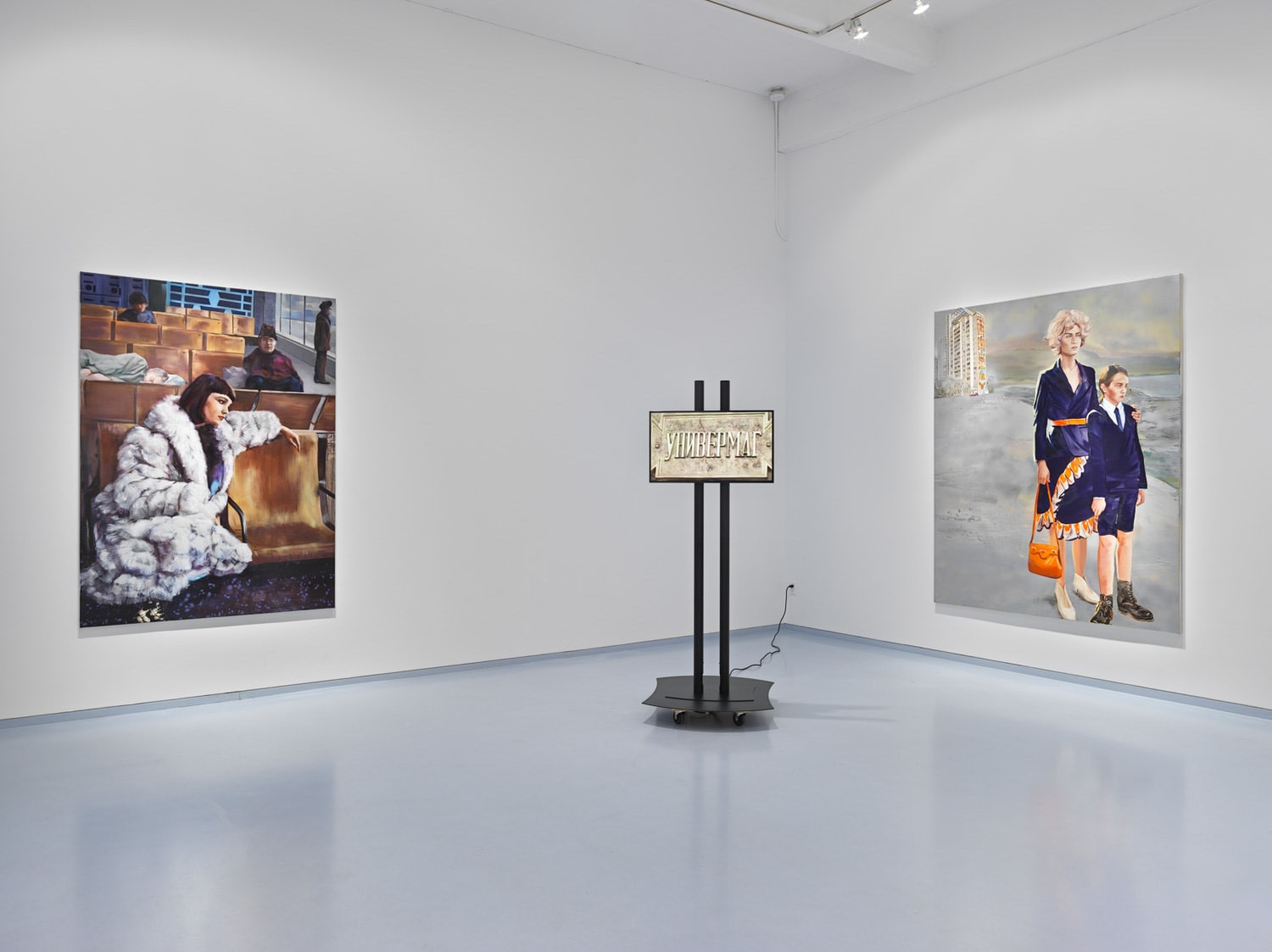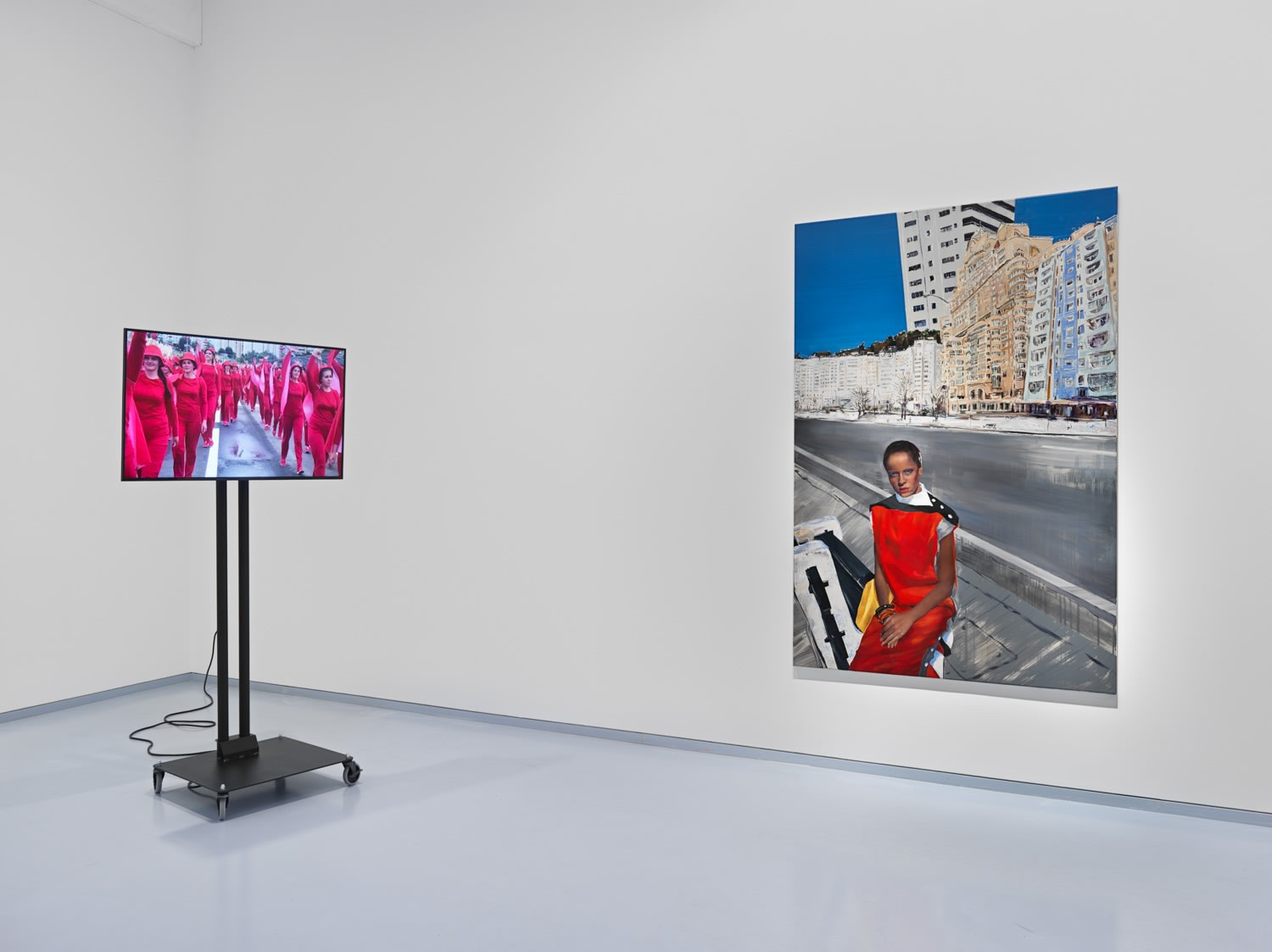Share economy. Review: "Belavia" by Paulina Olowska at Metro Pictures.
by Klairfontaine
from Issue 1—Winter 2019—We Regret To Inform You (Archive)

To prepare for the article I first try to find something about the show in Belarusian media, locating a single Facebook post by a poet and translator, a friend of Halina Zalatukha, the composer who created the “score” for the show. His motivational blurb goes something like: in New York City, in the heart of Manhattan, a very important cultural event for the country of Belarus is currently taking place. This is the show. Like “this is the girl” in Mulholland Drive.
This something important in cultural life of Belarus is Paulina’s effervescent and fragmentary video and painting exhibition centered around the topologies of the Minsk’s GUM department store.
The press-release calls the location Glavnyij Universalnyij Magazin (The Main Department Store), but in reality it’s called Gosudarstvennyi Universalnyi Magazin (The State Deparement Store), which makes a difference to the imbued meaning. Only Belarusian goods can be sold at GUM since it belongs to the State. The concept of the show appears to be built around the idea of a stagnant fantasy of consumerism. “Купляйце Беларускае!” (buy Belarusian!) is not quite meaningful: there is no choice to begin with. Paulina filmed the customers and the saleswomen performing dreamlike suspense of the soviet consumer cult that GUM had always been.
It’s clear to me, the show is reflecting on post-Soviet utopias. GUM, a concept, initially created as a Soviet version of the consumers paradise, the arcades project, like, let’s say, Macy’s. It’s clear to me, the show is proposing to reflect on the role of women within the panno, there are several paintings of them, allegedly Belarusian. And, it is clear to me, as a Belarusian that the expected punctures and gaps between the artist representation and my recollections — are there.
I have just enough time between days jobs to run over and to scoop it out on a coffee break with a friend. We do a quick circle around the gallery and can hardly believe this is it, the "very important cultural event for the country of Belarus". We see the paintings and several large screens showing videos. The music frustrates me, something in-between newage and apocalyptic post-industrial neofolk. Is there something I’m missing? Anxiously I scroll the composer’s Facebook page to verify for more meaningful layers of the unadorned surface. Is this irony or it she serious? A question that follows me too, as a writer.
Mounds of self-irony is what nearly poisoned the Belarusian art of the aughts. It grew to be an impossible feat to distinguish the irony from its offspring, post-irony. Like right now, in the States, where post-irony is sort of unofficially “banned”. I watch Bad Religion, whom I loved back in their hayday, release a music video “The Kids are Alt-Right” and get slammed as pro-alt-right. Though the tune is quite clearly ironic now that things are getting a little too real, the satire they try, strikes too close.
Same goes for Paulina’s soundtrack, newage vibe and ironic lyrics, indiscernible deadpan or serious, nothing to laugh at or the deliberately constructed many levels of self-irony is a proposal I fail to unlock. Though today, it isn’t the first time I find it hard to parse, a photo from a photo of a photo, a perfect lens and no visible tint to reveal the intention of the overlapped gesture. Instead of reveal of reframing, the same image, is here and here, again and again.
I know I would feel different had I seen this show at another time. Funny in 2000-s, and more frightening in the 90-s. Crucially, frozen GUM remains unchanged through the years. Filmed at any point in time within those decades it would have appeared the same.
For the artist the footage is ripe with ostalgia. Though the Belarusian architecture induces the sentiment in others, it isn’t the one I share. Paulina, who shuttled back and forth on Belavia (the name of Belarus' only airline) to make the work she presents at the Metro Pictures, describes her Minsk as “culturally frozen in time”, thus evoking “memories of her childhood growing up in communist Poland”. For me, as someone who lived it, what the footage evokes is anything but cherishable, rather something that I have seen to have perished. The Minsk of my childhood, brutally demolished, erased is destroyed, what’s left of the epic architecture of the Victory Avenue is a facade and what’s beyond has dramatically changed. Though true too, in fact nothing is changing. Inflexible and stiff, Minsk breaks to pieces with the lightest of pressure applied. In place of evolving or gradual change, there’s only — the damage.
This Soviet Facade I’m looking at in Chelsea is appealing and palatable. Western artists love to quote Minsk as the Sun City devised by the Belarusian writer and artist Artur Klinov. The Communist utopia forever brimming off the edges of Minsk’s pompous Stalinist architecture. For us it’s a non-place, for the fellow artists from Poland, it’s the memories of communist Poland, a common “chernuha” being perhaps the shared economy that what we see in each other.
Do victims of the same violent crime see each other as reflections, as mirrors, or as screens? In place of objective perspective, what I find is a distortion. When in Warsaw, I flood with nostalgia for the Soviet Minsk of my youth. Back at home, I feel nothing at all. All that’s’ left of that time is what can be grasped through each other. Only stranger still, is the Chelsea gallery’s ghostly western gaze presenting the absence that somehow grows through the imaginary recall of the 80’s Poland and through the non-changeable city of Minsk to fill the whole of the gallery space. What do the New York visitors see and what is gained from this vision?
When my friend and I look at the paintings we are struck by the the models, western look alikes of the 80-s Soviet glossies: the “independent” professional women, clothed in synesthetic and bright retro-futurist garb, against large buildings that trim enormously wide avenues leading to the edge of the painting’s plane and off its edge, to the abyss. The assurance of the painted women produces a clammy dissonance with the popular rubric of Belarusian “Citydog” magazine, the street fashion log of Minsk. Olowska’s women, unlike Minsk hipsters, are not merely fascinated with the western ways, they are self-sufficient, calm and encapsulated in their own crystal confidence. They don’t and never existed and it draws me in, I would have loved to be them in my past. While in Minsk I imagined myself as a mannequin stranger that floats, crossing the Central Station, like Ziggy Stardust or Thin White Duke, celebrating my alienated difference (or indifference), which probably was a mistake, since everything looks to be a mistake, in retrospect, these days.
I try and I can’t know what Americans see through this Belarusian Chelsea encounter. To know this, I’d need to die and be reborn again, here, in this country.
As I’m leaving the Metro Pictures I realize that the show and the space was, if just for a moment, like a visit back “home” — if another person’s nostalgia can be a home for someone unable to share in a feeling.

